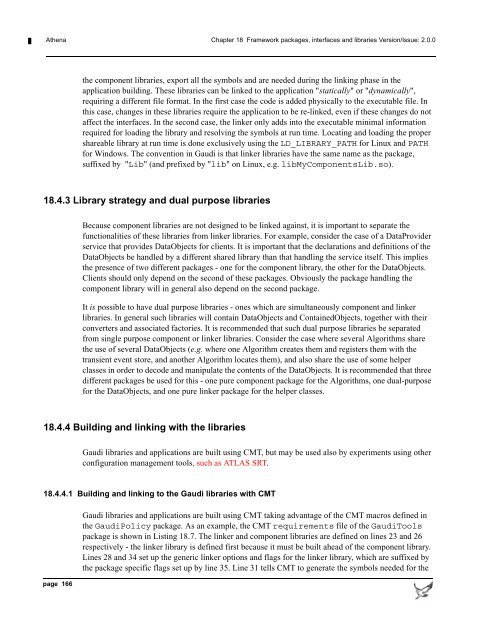Athena Developer Guide
Athena Developer Guide
Athena Developer Guide
Create successful ePaper yourself
Turn your PDF publications into a flip-book with our unique Google optimized e-Paper software.
<strong>Athena</strong> Chapter 18 Framework packages, interfaces and libraries Version/Issue: 2.0.0<br />
the component libraries, export all the symbols and are needed during the linking phase in the<br />
application building. These libraries can be linked to the application "statically" or "dynamically",<br />
requiring a different file format. In the first case the code is added physically to the executable file. In<br />
this case, changes in these libraries require the application to be re-linked, even if these changes do not<br />
affect the interfaces. In the second case, the linker only adds into the executable minimal information<br />
required for loading the library and resolving the symbols at run time. Locating and loading the proper<br />
shareable library at run time is done exclusively using the LD_LIBRARY_PATH for Linux and PATH<br />
for Windows. The convention in Gaudi is that linker libraries have the same name as the package,<br />
suffixed by "Lib" (and prefixed by "lib" on Linux, e.g. libMyComponentsLib.so).<br />
18.4.3 Library strategy and dual purpose libraries<br />
Because component libraries are not designed to be linked against, it is important to separate the<br />
functionalities of these libraries from linker libraries. For example, consider the case of a DataProvider<br />
service that provides DataObjects for clients. It is important that the declarations and definitions of the<br />
DataObjects be handled by a different shared library than that handling the service itself. This implies<br />
the presence of two different packages - one for the component library, the other for the DataObjects.<br />
Clients should only depend on the second of these packages. Obviously the package handling the<br />
component library will in general also depend on the second package.<br />
It is possible to have dual purpose libraries - ones which are simultaneously component and linker<br />
libraries. In general such libraries will contain DataObjects and ContainedObjects, together with their<br />
converters and associated factories. It is recommended that such dual purpose libraries be separated<br />
from single purpose component or linker libraries. Consider the case where several Algorithms share<br />
the use of several DataObjects (e.g. where one Algorithm creates them and registers them with the<br />
transient event store, and another Algorithm locates them), and also share the use of some helper<br />
classes in order to decode and manipulate the contents of the DataObjects. It is recommended that three<br />
different packages be used for this - one pure component package for the Algorithms, one dual-purpose<br />
for the DataObjects, and one pure linker package for the helper classes.<br />
18.4.4 Building and linking with the libraries<br />
Gaudi libraries and applications are built using CMT, but may be used also by experiments using other<br />
configuration management tools, such as ATLAS SRT.<br />
18.4.4.1 Building and linking to the Gaudi libraries with CMT<br />
page 166<br />
Gaudi libraries and applications are built using CMT taking advantage of the CMT macros defined in<br />
the GaudiPolicy package. As an example, the CMT requirements file of the GaudiTools<br />
package is shown in Listing 18.7. The linker and component libraries are defined on lines 23 and 26<br />
respectively - the linker library is defined first because it must be built ahead of the component library.<br />
Lines 28 and 34 set up the generic linker options and flags for the linker library, which are suffixed by<br />
the package specific flags set up by line 35. Line 31 tells CMT to generate the symbols needed for the
















